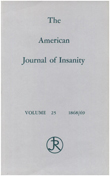Examining the validity of DSM-III-R schizoaffective disorder and its putative subtypes in the Roscommon Family Study
Abstract
OBJECTIVE: The authors sought to assess whether the DSM-III-R category of schizoaffective disorder differs meaningfully from schizophrenia and affective illness in clinical features, outcome, and familial psychopathology. In addition, the authors evaluated the validity of two proposed subtyping systems for schizoaffective disorder: 1) bipolar versus depressive (based on presence or absence of a full manic syndrome in the past) and 2) good versus poor interepisode recovery. METHOD: In the epidemiologically based Roscommon Family Study, index probands with diagnoses of schizophrenia or affective illness were selected from a case registry. Personal interviews were conducted with 88% of traceable, living probands and 86% of traceable, living first- degree relatives. RESULTS: Probands with schizoaffective disorder differed significantly from both those with schizophrenia and those with affective illness on lifetime psychotic symptoms as well as on outcome and negative symptoms assessed as follow-up. Relatives of probands with schizoaffective disorder had significantly higher rates of affective illness than relatives of schizophrenic probands and significantly higher rates of schizophrenia than relatives of probands with affective illness. Probands with bipolar and depressive schizoaffective disorder did not differ substantially with respect to psychotic symptoms, negative symptoms, outcome, or family history. Schizoaffective disorder probands with good interepisode recovery had fewer negative symptoms and a better outcome than those with poor recovery, but there were no significant differences in family history. Both the epidemiologic and family data are consistent with the hypothesis that schizoaffective disorder results from the co-occurrence of a high liability to both schizophrenia and affective illness. CONCLUSIONS: On the basis of the validators examined, DSM-III-R criteria for schizoaffective disorder define a syndrome that differs meaningfully from both schizophrenia and affective illness. The division of schizoaffective disorder into bipolar and depressive subtypes was, however, not validated. The separation of schizoaffective disorder into subtypes based on level of interepisode recovery defined subtypes that differed clinically but not with respect to familial psychopathology.
Access content
To read the fulltext, please use one of the options below to sign in or purchase access.- Personal login
- Institutional Login
- Sign in via OpenAthens
- Register for access
-
Please login/register if you wish to pair your device and check access availability.
Not a subscriber?
PsychiatryOnline subscription options offer access to the DSM-5 library, books, journals, CME, and patient resources. This all-in-one virtual library provides psychiatrists and mental health professionals with key resources for diagnosis, treatment, research, and professional development.
Need more help? PsychiatryOnline Customer Service may be reached by emailing [email protected] or by calling 800-368-5777 (in the U.S.) or 703-907-7322 (outside the U.S.).



